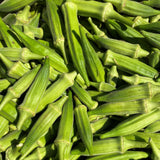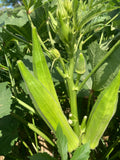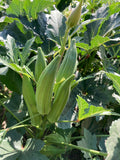Cajun Jewel Okra
Abelmoschus esculentus
2½ to 4 foot tall plants with 1 inch thick (up to 8 inches long), slender and tender, spineless fruits. Introduced in 1989 by Southern Exposure Seed Exchange who report that it has been a local favorite in Cajun country since the 1950s.
Here are some reflections on this okra from Gail Taylor of Black Dirt Farm Collective:
For our first crop to grow as seed for the Truelove catalog we chose Okra, a crop with great significance for those of us who are in the diaspora. It's a crop that connects us directly back to our homeland. It is the centerpiece of the Black Dirt Farm Collective logo.
The variety we chose is Cajun Jewel, which is the first variety that I experienced as a grower - from the itchy harvests to the invitation from my fellow farmers to try it raw, I've spent most of the past 15+ years growing and eating Cajun Jewel. The way that the pods set on the plants make for an easy, efficient harvest. It doesn't feel like as much of a scavenger hunt as with some other varieties. The height stays manageable, even for my 5'4" frame.
I like that the pods have a nice shape to them. They are not too slender and have definition around the edges. Harvest them small enough (use your middle finger as a guide) and urge even the most skeptical of okra skeptics to try this vegetable. A pint basket full of finger-size okras doesn't require any cutting so no one can complain about the slime. This gateway oven roasting method eventually wins everyone over and soon we're all eating stews together where okra gets to shine in all of her glory, letting the stew thickening properties out of the shell.
Days to maturity: 50-60
Seeds per pack: 50-60
Germination rate: 95% 05/23/2025
Planting / harvesting notes
Sow seeds of this heat-loving plant indoors 2-3 weeks before transplanting, which should happen several weeks after the last frost, or when soil temperatures stay above 65 degrees Fahrenheit. Soak seeds overnight for quicker germination, and plant 3/4" deep. Space 18" in rows 12-18" apart. Beds should be at least 3' apart as plants tend to bush out widely. Okra likes fertile, well-drained soil with added compost.
Seed keeping notes
Okra is insect pollinated. Isolate different okra varieties by at least 1/8th of a mile (or up to 1/2 mile if you are truly concerned about seed purity) to avoid unwanted cross pollination. Allow pods to grow large and turn brown and woody (your neighbors may look at you funny). When you can hear the seeds rattle, harvest the pod and allow it to dry further on trays in the sun in a dry place. Remove seeds and use breath, wind, or fans to remove bits of chaff.











